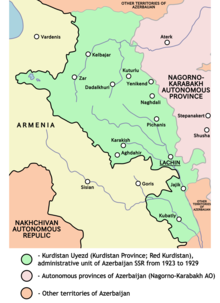Red Kurdistan
The Red Kurdistan ( Kurdish Kurdistana Sor , Azerbaijani Qizil Kürdistan , Russian Красный Курдистан ) denotes an autonomous province in the former USSR , which existed from 1923 to 1929.
history
The area between the Azerbaijani Nagorno-Karabakh and the Armenian Sjunik was settled by Kurdish tribes in the 18th century . Eventually they became the majority in this area, especially around Laçın ( Kurdish Laçîn ), Kəlbəcər ( Kurdish Kelbajar ) and Qubadlı ( Kurdish Qûbadlî ).
In 1920 this region became a part of the Azerbaijani Soviet Socialist Republic . On May 23, 1923, the area received the status of an autonomous district ( Ujesd ) within Azerbaijan and was named Red Kurdistan . However, other Kurdish areas were not given a national circle and were not allowed to join the Red Kurdistan. The official language of Red Kurdistan became Kurmanji and its administrative center Laçın.
According to the census in the Soviet Union in 1926, 51,200 people lived in Red Kurdistan, of which 37,470 (73.1%) Kurds , 13,520 (26.3%) Azerbaijanis and 256 (0.5%) Armenians .
Dissolution of Red Kurdistan
In 1929 the autonomous province was dissolved by a resolution of the 6th Azerbaijani Soviet Congress. Nevertheless, the state initially promoted Kurdish culture for a few more years. Native-speaking schools emerged and the newspaper Soviet Kurdistan was published in Laçın . In 1937/38 this course changed in favor of a policy of ethnic homogenization. During these years, many Kurds were deported to Central Asia from the areas near the border with Iran and Turkey. The attempt to re-establish it as an independent state in 1989 failed because of the collapse of the Soviet Union . Moreover raged 1992-1994 Nagorno-Karabakh conflict between Armenia and Azerbaijan to the east located Nagorno-Karabakh , which drove most of Kurds from the rest of the territory. Today the region is controlled by the Armenians of the Nagorno-Karabakh Republic .
Web links
- Article about Red Kurdistan
- Давид Бабаян: Красный Курдистан - Геополитические аспекты создания и упразднения. «21-й ВЕК», № 2, 2005г. (PDF; 260 kB) 2005 (Russian)
Individual evidence
- ↑ Давид Бабаян (2005), p. 115
- ↑ On the Stalinist deportations of nationalities in the Caucasus see this map (in Russian) by the historian Artur Zuzijew. Below that, as the first field of the legend (white, dashed) “Kurds and Iranians from zones near the border in Armenia and Azerbaijan (1937-38)”.

